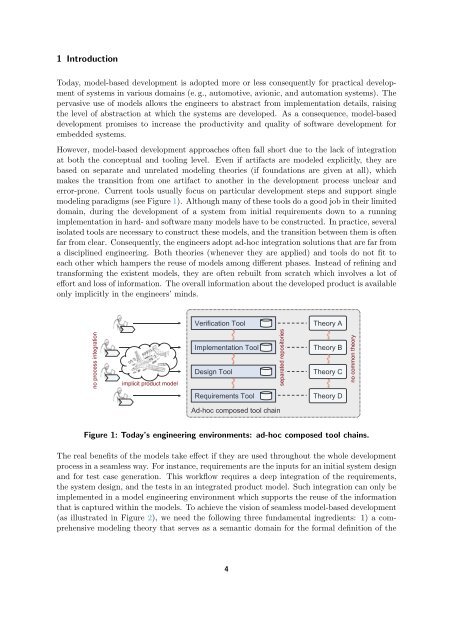SPES 2020 Deliverable 1.4.B-3 Concepts for an Integrated Tool ...
SPES 2020 Deliverable 1.4.B-3 Concepts for an Integrated Tool ...
SPES 2020 Deliverable 1.4.B-3 Concepts for an Integrated Tool ...
You also want an ePaper? Increase the reach of your titles
YUMPU automatically turns print PDFs into web optimized ePapers that Google loves.
1 Introduction<br />
Today, model-based development is adopted more or less consequently <strong>for</strong> practical development<br />
of systems in various domains (e. g., automotive, avionic, <strong>an</strong>d automation systems). The<br />
pervasive use of models allows the engineers to abstract from implementation details, raising<br />
the level of abstraction at which the systems are developed. As a consequence, model-based<br />
development promises to increase the productivity <strong>an</strong>d quality of software development <strong>for</strong><br />
embedded systems.<br />
However, model-based development approaches often fall short due to the lack of integration<br />
at both the conceptual <strong>an</strong>d tooling level. Even if artifacts are modeled explicitly, they are<br />
based on separate <strong>an</strong>d unrelated modeling theories (if foundations are given at all), which<br />
makes the tr<strong>an</strong>sition from one artifact to <strong>an</strong>other in the development process unclear <strong>an</strong>d<br />
error-prone. Current tools usually focus on particular development steps <strong>an</strong>d support single<br />
modeling paradigms (see Figure 1). Although m<strong>an</strong>y of these tools do a good job in their limited<br />
domain, during the development of a system from initial requirements down to a running<br />
implementation in hard- <strong>an</strong>d software m<strong>an</strong>y models have to be constructed. In practice, several<br />
isolated tools are necessary to construct these models, <strong>an</strong>d the tr<strong>an</strong>sition between them is often<br />
far from clear. Consequently, the engineers adopt ad-hoc integration solutions that are far from<br />
a disciplined Technische engineering. Universität München Both theories (whenever they are applied) <strong>an</strong>d tools do not fit to<br />
each other which hampers the reuse of models among different phases. Instead of refining <strong>an</strong>d<br />
Today’s ad-hoc composed tool chains<br />
tr<strong>an</strong>s<strong>for</strong>ming the existent models, they are often rebuilt from scratch which involves a lot of<br />
ef<strong>for</strong>t <strong>an</strong>d loss of in<strong>for</strong>mation. The overall in<strong>for</strong>mation about the developed product is available<br />
only implicitly in the engineers’ minds.<br />
no process integration<br />
Verification <strong>Tool</strong><br />
Implementation <strong>Tool</strong><br />
repositories<br />
Design <strong>Tool</strong><br />
implicit product model separated<br />
Requirements <strong>Tool</strong><br />
Ad-hoc composed tool chain<br />
Theory A<br />
Theory B<br />
Theory C<br />
Theory D<br />
Figure 1: Today’s engineering environments: ad-hoc composed tool chains.<br />
The real Garching, benefits 11.11.2008 of the models Stef<strong>an</strong>o take Merenda, effect Chair IV: Software if they <strong>an</strong>d Systems are used Engineering throughout the whole development<br />
2<br />
process in a seamless way. For inst<strong>an</strong>ce, requirements are the inputs <strong>for</strong> <strong>an</strong> initial system design<br />
<strong>an</strong>d <strong>for</strong> test case generation. This workflow requires a deep integration of the requirements,<br />
the system design, <strong>an</strong>d the tests in <strong>an</strong> integrated product model. Such integration c<strong>an</strong> only be<br />
implemented in a model engineering environment which supports the reuse of the in<strong>for</strong>mation<br />
that is captured within the models. To achieve the vision of seamless model-based development<br />
(as illustrated in Figure 2), we need the following three fundamental ingredients: 1) a comprehensive<br />
modeling theory that serves as a sem<strong>an</strong>tic domain <strong>for</strong> the <strong>for</strong>mal definition of the<br />
4<br />
no common theory
















